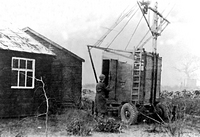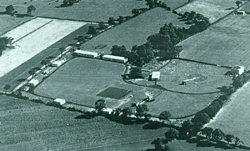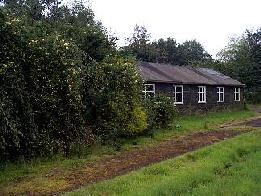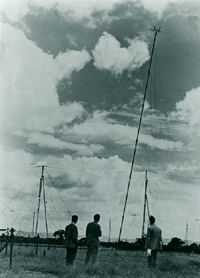The Early History
Prior to the Second World War Dr. Bernard Lovell was studying cosmic rays using a Wilson Cloud Chamber in the Physics Department of the University of Manchester. Whilst working on the development of radar systems during the war he became aware of sporadic echos that were being detected by our early warning radar systems. He wondered if these might be caused by the passage of a cosmic ray particle through the atmosphere and so, when the war ended, he acquired some army radar equipment which he set up in the quadrangle outside the Schuster Laboratory in Manchester.
Interference from the trams along Oxford Road made him seek a site well away from the centre of Manchester. He found that the Botany Department had some land in Cheshire at a place called Jodrell Bank - a bank being a small river valley cutting across the Cheshire Plain, this one being named after the Jaudrell family.
The first observations were made in the middle of December 1945, and many echos were received. It soon became apparent that they were not due to cosmic ray particles entering the atmosphere but were instead echos from "shooting stars", the plasma trail of a meteor as it burns up in the atmosphere! Lovell and his students were able to show that many meteors are the dust particles released by a comet as it rounds the sun. These originally form the "dust tail" of the comet - as you will have seen if you observed comet Hale-Bopp in 1997.
The two huts in the Botany Department's grounds are still there, but the sapling seen in the left of the 1945 picture above has now grown so big it hides one of them.
Over the next few years Lovell and his expanding team built up the Jodrell Bank Experimental Station in the adjoining field. The key development was the building, in 1947, of a 218ft parabolic reflecting aerial - by far the largest radio telescope in the world at that time. The wire mesh that reflected the radio signals to a focal pint 150ft above the ground was suspended from a ring of scaffold poles. You can just make out the telescope to the left of the large building in the centre right that housed the diesel generators which provided power for the site.
This photograph shows the telescope in more detail. By tilting the position of the mast the beam could be swung to allow different parts of the sky to be scanned as the earth's rotation brought it overhead.
The telescope made many important discoveries, particular among them being the detection of radio noise from the Great Nebula in Andromeda - the first time that a known extragalactic radio source had been detected - and the detection of the remains of the supernova of 1572, usually known as Tycho's supernova, which does not have any obvious visual remnant.
Even though this telescope could only survey that part of the sky that came near to the zenith, its great sucess led Lovell to seek funds for the building of a telescope of similar size which could be used to observe all of the sky visible at the latitude of Jodrell Bank - so the story of the building of the MK1, 250ft Radio telescope began.






